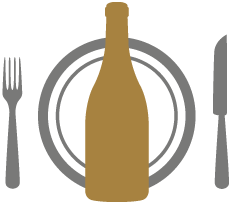Vintage Select
\ˈvin-tij\ \sə-ˈlekt\ - Vintage wines selected to pair perfectly with your dining experience.

We encourage responsible enjoyment of our wines. Please confirm you are at least 21 years of age by entering your birth date below.
You must be 21 to enter this site.
\ˈvin-tij\ \sə-ˈlekt\ - Vintage wines selected to pair perfectly with your dining experience.
Good food and wine appeal to the senses. It should be attractive to look at, a pleasure to smell, feel good in the mouth and be pleasing to the taste.
Most people will order the dish that most appeals to them and drink a wine they are familiar with. They are often not concerned about it being the “perfect” pairing. The good news is that most food and wine pairings work! Very few clash. However, there are a few ways to make the pairing foolproof.

Major ingredients in the food
Predominate flavors in the completed dish
Texture of finished product
Cooking method utilized
Determine the overall intensity of flavors, not just those of the main ingredient. Determine the wine’s intensity, flavors and texture. Learn the basics—Complement or Contrast.
Match the food and wine on intensity—that is, match a lightly flavored dish with a lighter style wine, either white or red. Texture and flavors—after matching for intensity, match food and wine on similar flavors.
A medium-bodied Chardonnay with tropical fruit flavors with a pork chop with pineapple salsa. Or a buttery Chardonnay with lobster and drawn butter.
Yes, opposites do attract.
Riesling (off-dry to sweet) and calamari with Cajun spice. Or, a bright, more acidic white, such as Sauvignon Blanc with a rich cream sauce.
Balanced dishes will usually match balanced wine.
Spicy food makes wine taste more “hot” or astringent, so pair it with a soothing wine with either sweetness, such as a sweet style Moscato or Riesling, or a very fruity wine such as Pinot Grigio.
Salty foods accentuate oakiness in white wines, but complement fruitiness and sweetness.
Protein and fat in meats soften the tannins and astringency of red wines. That is why a Cabernet Sauvignon pairs so well with a steak.
Protein cuts the acidity of a wine and makes it appear softer.
Sweet foods make wine taste more acidic and/or bitter.
Smoked foods, especially seafood, tend to dominate the taste of wines. Avoid high-acid wines in favor of semi-dry ones.
Adding salt or acid to a dish will usually balance the wine and makes the flavors of the combination more lively.
Tart, sour, or acidic foods (citrus, tomatoes, vinegar) are best paired with low-acid wines, as they tend to tone down the acidity in food.
Washington Wine Commission's Wine 101
view websiteWine Institute's Wine & Food
view websiteOregon Wine Board’s Wine Information
view website